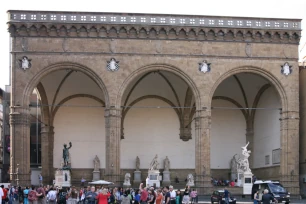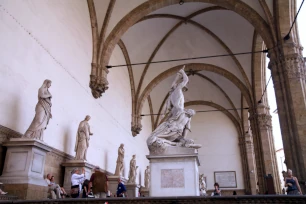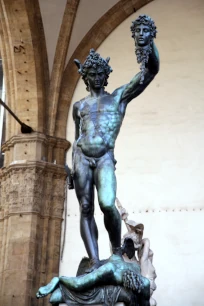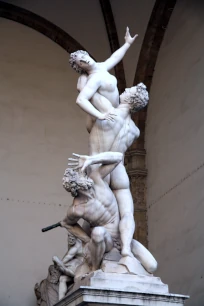The Loggia dei Lanzi is a beautiful, arched gallery that was built in the 14th century at the Piazza della Signoria right in front of the Palazzo Vecchio. This famous loggia served as a model for many loggias that were later built across Europe.



The original purpose of the loggia was to shield dignitaries from the elements during ceremonies, public meetings and events. Today it houses a number of statues, the most notable being a statue showing Perseus after he killed Medusa.
The Loggia
The covered gallery with three large arches was built between 1376 and 1382 by the Florentine architect Simone di Francesco Talenti and the Lombardian-born architect Benci di Cione Dami. The beautifully proportioned open gallery was designed in a late Gothic style, a clear precursor to the soon-to-be popular Renaissance style. Michelangelo, one of the most prominent Renaissance artists, even proposed to extend the gallery along all sides of the Piazza della Signoria, but Cosimo I de’ Medici, Duke of Florence, eventually decided it would be too expensive.
The Loggia dei lanzi is named after the personal guards of Cosimo I, Swiss pikemen who were known as the Lanzi (derived from the German word Landsknecht). For some time around 1527, they were stationed at the loggia.



Installing the Statues
The Loggia dei Lanzi is almost like an outdoor museum with its collection of impressive Renaissance and Roman sculptures. The tradition of installing statues in the loggia started in 1494 when the Florentines expelled the Medici, who had ruled over the city for more than 150 years.
To celebrate the revolt against the former rulers, Florentine citizens transported Donatello’s statue of Judith and Holofernes from the palace of the Medici to the piazza in front of the Palazzo Vecchio. The choice of the statue was no coincidence: it depicts a woman decapitating a tyrant and symbolized the end of the reign of the Medici.
The house of Medici soon regained its power in Florence, and duke Cosimo I commissioned Benvenuto Cellini to create a sculpture depicting the mythical hero Perseus after he beheaded Medusa. After its completion in 1554, the statue was placed at the Loggia dei Lanzi as a warning to potential enemies of the duke.
The Statues Today
Today, the bronze statue of Perseus is still the highlight of the loggia, even though the collection of statuary has expanded over time with a number of other impressive statues.
One of these masterpieces is the Abduction of the Sabine Virgins, a marble sculpture group created in 1585 by Giambologna, a Flemish sculptor best known by his Italian name.
Another statue in the loggia by the same artist is called ‘Hercules slaying the Centaur Nessus’. It was created in 1599, but only added to the loggia in 1841. There are two more sculpture groups at the center of the loggia: ‘Menelaus supporting the body of Patroclus’, an originally Roman statue restored in the 16th century and placed here in 1838 and ‘The Abduction of Polyxena’, a 19th century sculpture group created by the Italian artist Pio Fedi.
Six more sculptures – known as the Sabines – line the back wall of the loggia. The marble Roman statues, depicting female figures, were installed here in 1789. Two large marble lion statues flank the entrance to the loggia. The lion on the right looking from the Piazza della Signoria dates back to Antiquity, while the one on the left was created in 1598 by the Italian sculptor Vacchi and placed here in 1789.

